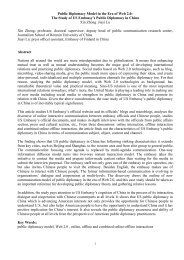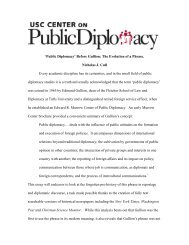Buddhist Diplomacy: History And Status Quo. - USC Center on ...
Buddhist Diplomacy: History And Status Quo. - USC Center on ...
Buddhist Diplomacy: History And Status Quo. - USC Center on ...
- No tags were found...
You also want an ePaper? Increase the reach of your titles
YUMPU automatically turns print PDFs into web optimized ePapers that Google loves.
BUDDHIST DIPLOMACY: HISTORY AND STATUS QUO 7to the Sangha. The Kosala King Pasenadi and his wife Queen Mallikaalso became followers of the Buddha. 6 King Pasenadi frequentlysought advice from the Buddha. He also made c<strong>on</strong>fessi<strong>on</strong>s to him<strong>on</strong> his wr<strong>on</strong>gdoings. 7 After Magadha Prince Ajatashatru impris<strong>on</strong>edand starved his father King Bimbisara to death to take his thr<strong>on</strong>e,he repented of his sin and made c<strong>on</strong>fessi<strong>on</strong>s to the Buddha. TheBuddha c<strong>on</strong>verted him into a follower. 8 On <strong>on</strong>e occasi<strong>on</strong> whenKing Pasenadi fought and captured King Ajatashatru, the Buddhapers<strong>on</strong>ally persuaded King Pasenadi to release King Ajatashatru. 9When King Ajatashatru planned to invade the Vajji Republic, he senthis Prime Minister Vassakara to the Buddha to indirectly discoverwhether in the Buddha’s view there were any chances of c<strong>on</strong>queringthe Vajjians. The Buddha said that as l<strong>on</strong>g as the Vajjians practicedthe seven c<strong>on</strong>diti<strong>on</strong>s of prosperity, they would prosper rather thandecline. As a result, a potential invasi<strong>on</strong> was diffused. 10During the Buddha’s life time, he not <strong>on</strong>ly sent his disciples tothe kingdoms to spread the message of the Dharma, he pers<strong>on</strong>allywandered from <strong>on</strong>e kingdom to another to teach the Dharma. Forexample, the Samyutta Nikaya records that a minister of the Kosalacourt said that he felt extremely sad to learn that the Buddha wasleaving Kosala for other kingdoms to teach Dharma, because hewould not be able to see the Buddha for a good period of time. Thekingdoms included Kāśi, Malla, Magadha, Anga, Samatata, Bentara,and Kalinga. 11 Throughout his forty-five years’ of teaching, manykings, queens, princes and nobles became the Buddha’s followers,al<strong>on</strong>g with numerous people of low castes, from beggars toprostitutes. 12 The Digha-nikaya reports that six peoples in the sixteenkingdoms followed the Buddha’s teachings during his lifetime. 13But <strong>on</strong>e of the Buddha’s last involvements in diplomatic affairswas tragically related to his home country, the Sakya tribe. TheKosala King Pasenadi’s s<strong>on</strong> Virudhaka dethr<strong>on</strong>ed his father and wasdetermined to invade the Sakya people’s capital city Kappilavasttuto revenge the humiliati<strong>on</strong> he supposedly suffered there when hewas a boy. For three times the Buddha tried to stop the King and histroops <strong>on</strong> the road, but eventually the Sakyas were left to their fate.











